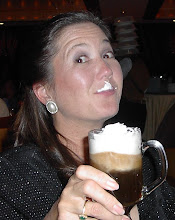
1) I probably should have known this, but I’ll admit, at the point in history when “Czechoslovakia” became the Czech Republic, I was not yet a “news junkie.” I didn’t pay attention to the news of the world, probably because my life was too full of taking care of my two young children, going to school and working. Therefore, before we planned this trip to Prague, I didn’t realize Czechoslovakia no longer existed, and that it is now the Czech Republic and Slovakia.
2) I’d always heard the term “Bohemian,” and perhaps even strived to be such a person — artistic, free-spirited, unconventional. Before we traveled to the Czech Republic, I didn’t know that Bohemia is a REAL place, the largest region in the Czech Republic. It consists of a central basin surrounded by mountain ranges. We visited Prague, which is in Central Bohemia, and Cesky Krumlov, a UNESCO World Cultural Heritage Site, in South Bohemia.

3) In studying the history of the Czech Republic, I learned the meaning of two words I’d never heard before: defenestration and immolation.
Defenestration – the act of throwing a thing or person out of a window. The first “Prague Defenestration” occurred in 1419, when several Catholic councilors were thrown from the window of Prague’s New Town Hall during the reformation movement, which demanded the restraint of the church in state affairs. A second “Prague Defenestration” occurred in 1618, representatives of the non-Catholic Bohemian states threw two of Emperor Matthias’s emissaries out of a window at Prague Castle. It marked the beginning the The Thirty Years War, which lasted until 1648.
Immolation – the act of sacrifice, as if by fire. In 1969, twenty-year old Jan Palach burned himself to death to protest the invasion of Czechoslovakia by troops of the Warsaw Pact, by order of the Soviet Union. This invasion signaled the end of “Prague Spring,” and resulted in the return of orthodox Communists to power.
4) I learned the beloved Christmas carol “Good King Wenceslas” was based on Saint Wenceslaus I, Duke of Bohemia, (907-935). He is the Patron Saint of the Czech Republic.
5) If I had been born in Czechoslovakia, I would have been two years old when the “Prague Spring” began. This was a reform movement within the Communist party which had taken over the country after the Red Army liberated Prague from the Nazis during World War II. I would have been ten years old when in August, 1968, the “Prague Spring” ended and the Soviet Union and members of the Warsaw Pact invaded Czechoslovakia to halt the period of political liberalization and return the country to orthodox Communism.

At the time of the Velvet Revolution, a non-violent uprising that began in November, 1989, I would have been thirty-one years old. By then, I had two children. One of our tour guides, who looked to be about the age of my children, told us that during the period from 1968 – 1989, parents told their children to “blend in. Don’t do anything to stand out.” I found this fascinating. I never thought of Communism in those terms – that it would change the whole way one might parent their children.
The young woman who was our tour guide (center in the picture below,) told us about the year she spent as an au pair in America. Though she was initially disappointed that the “American Dream” was not all she hoped it would be, she came away with a determination to speak her mind, to stand out, to be an individual.

This to me, was the most serendipitous lesson from my trip to the Czech Republic, because in learning about the history of this country, and in talking to people who had lived through Communism coming in and out of their country, I saw what we so often take for granted in America -- the freedom to stand out, and to be an individual --perhaps even Bohemian!






No comments:
Post a Comment